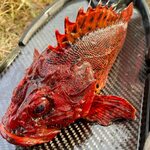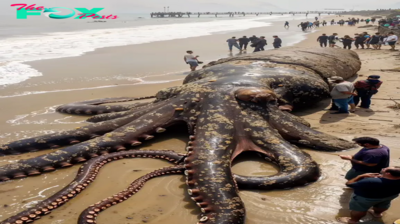Mysterious
AK In an unexpected twist, a man’s fishing expedition led to the accidental hooking of a uniquely shaped red fish, leaving everyone astonished by its bizarre and captivating appearance.
Fishing is a popular pastime for many people, and catching a rare or unusual fish can be an exciting experience.
Identify the Strange Red Fish: The first step to catching a strange red fish is knowing what to look for. These fish are usually small to medium in size, with a distinctive bright red color that sets them apart from other species. They may also have unique patterns or markings that help them blend into their surroundings.
 Some common types of red fish include red snapper, redfish, and red sea bass. Take some time to research the different species and their habitats so you can increase your chances of catching them. they. Find the right place. Once you’ve identified the strange red fish you want to catch, it’s time to find the right spot. These fish can be found in different areas of the ocean depending on their species, so it’s important to do your research. Some species of redfish prefer shallow water, while others are found in deeper water offshore.
Some common types of red fish include red snapper, redfish, and red sea bass. Take some time to research the different species and their habitats so you can increase your chances of catching them. they. Find the right place. Once you’ve identified the strange red fish you want to catch, it’s time to find the right spot. These fish can be found in different areas of the ocean depending on their species, so it’s important to do your research. Some species of redfish prefer shallow water, while others are found in deeper water offshore.
Consider factors such as water temperature, currents, and the types of bait and lures that work best for these fish when choosing a location. Fishing Techniques: When it comes to catching rare red fish, there are a few different techniques you can try. A popular method is to use live or cut bait, such as squid or shrimp, on a hook with a sinker or jig. Another technique is to use artificial lures, such as plastic worms or crankbaits, which mimic the movement of the fish’s natural prey.

Experiment with different techniques and see what works best for the type of redfish you are targeting. Safety and Conservation: While catching a rare red fish can be an exciting experience, it is important to prioritize safety and conservation. Be sure to use proper fishing gear and techniques to avoid injuring the fish or damaging their habitat.

Always follow local rules and guidelines for fishing, including size and bag limits, and consider releasing any fish you don’t plan to eat. By practicing responsible fishing practices, you can help ensure that these unique and fascinating species are present for future generations to enjoy.
-

 Mysterious2w ago
Mysterious2w agonht.”Exploring Humanity’s Pursuit of the Legendary 9-Meter, 4-Ton Giant.”
-

 Mysterious2w ago
Mysterious2w agonht.Once-In-A-Lifetime Footage Of A Massive Humpback Whale Leaping Out Of The Water Next To A Fishing Boat
-

 Mysterious3w ago
Mysterious3w ago.Global Sensation: Mesmerizing Footage of Giant Prehistoric Swordfish Captivates Audiences..D
-

 Mysterious3w ago
Mysterious3w agonht.The discovery of a peculiar creature with human and fish-like features is causing a stir on social media.
-

 Mysterious3w ago
Mysterious3w agonht.Google Maps reveals a possible extraterrestrial portal near Area 51, sparking widespread interest in the UFO community.
-

 Mysterious3w ago
Mysterious3w ago.Heroic Act: Rescuing Live Turtles from Fish Markets and Returning Them to the Ocean..D
-

 Mysterious3w ago
Mysterious3w agoB83.Exploring the Universe: Alien Forms and Their Extraordinary Means of Transportation Revealed
-

 Mysterious3w ago
Mysterious3w agoB83.The Goblin Man: A Remarkable 5,500-Year-Old Mummy and the Secrets of His Preservation

























